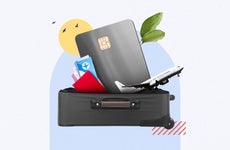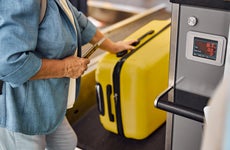How credit cards can help you deal with lost luggage

The Bankrate promise
At Bankrate we strive to help you make smarter financial decisions. While we adhere to strict , this post may contain references to products from our partners. Here's an explanation for .
There’s no faster way to ruin a long-awaited vacation than discovering that an airline has lost your luggage.
While the odds of that nightmare scenario happening are improving, more than 154,600 bags were mishandled by airline carriers in November 2023 alone, according to the U.S. Department of Transportation.
While more travelers are opting to fly with only a carry-on these days, that’s not always possible for extended vacations or during the holidays, when we tend to load up our bags with gifts for family and friends. So, what can flyers do to protect themselves against the agony of an AWOL suitcase?
For starters, many top rewards credit cards already include surprisingly comprehensive travel protections, including insurance coverage for baggage mishaps. Two types of luggage insurance typically offered include incidents of lost baggage and baggage that is severely delayed by several hours. For delays, that means your credit card issuer will often reimburse you for any necessities purchased while you wait for your bag to turn up — including those for toiletries, medication and clothing.
In the event that your baggage is lost indefinitely, you may be entitled to a full refund — so long as you purchased the flight with an eligible credit card and can provide adequate proof to support your claim. The extent of coverage varies by card. Generally, premium rewards cards offer the broadest coverage. However, even premium credit cards have exceptions in place when it comes to jewelry, electronics and other high-value items.
Bankrate’s take: For expensive items or gifts you’re better off packing them in your carry-on. If you absolutely must check a bag, purchase excess valuation insurance from your airline. This will offer additional coverage beyond the airline’s standard liability.
How to file a lost luggage claim with your credit card issuer
As with most types of insurance, the process of filing a claim isn’t so straightforward. Prepare to wade through a lot of fine print. For example, to qualify for coverage, some cards require that you’ve already paid for the entire cost of the flight, while others are OK with just partial payment.
Credit card baggage insurance typically provides secondary coverage — meaning you must first file your claim with the carrier responsible for the loss. In this case, that’s your airline (though it can also include cruise ships and trains). Once you’ve determined your bag indeed has been lost, do not leave the airport without filing a missing baggage report at your airline’s baggage desk. Smaller airlines may not always have a dedicated baggage desk and may instead use contractors that handle baggage services for multiple carriers.
Keep in mind: Most credit card baggage delay coverage typically kicks in after your bag has been missing for longer than six hours, after which you may be reimbursed for necessities. However, this benefit is usually capped at $500 per ticket, so it’s by no means an invitation to shop until you drop.
While the majority of missing bags are only temporarily lost and eventually located by the airline, that’s not always the case. Some airlines will consider your bag permanently lost after 14 days, though here, too, that number can vary by carrier. Once this occurs, you’ll need to file a second, more detailed claim with the airline, often providing an itemized list and receipts to prove the value of the missing contents. Remember, the value of your items depreciates after purchasing, so don’t expect to get back exactly what you paid for a pair of jeans two years ago.
Once you have confirmation of the claim you’ve filed with your carrier, you can contact your benefits administrator to begin a claim with your credit card company. The allotted window for making your lost baggage claim will vary by card. Most range from 20 to 90 days from the date your bag went missing.
In addition, every credit card has slightly different requirements regarding what documentation you need to submit with your claim. Besides your original claim to the airline and original receipts, you may be asked to provide a travel itinerary, card statement with your flight purchase and proof of any reimbursements made by the airline.
Best credit cards for delayed or lost luggage insurance
Chase Sapphire Reserve
-
The Chase Sapphire Reserve® remains a favorite among travelers thanks to its valuable welcome bonus — earn 75,000 points after spending $4,000 within the first three months of account opening — lucrative rewards rates and attractive perks. For instance, you’ll get Priority Pass Select lounge membership, up to $100 in Global Entry and TSA PreCheck credits and up to $300 in qualifying travel credits per year. An annual fee of $550 applies.
Notable travel coverage: The Chase Sapphire Reserve offers coverage of lost or damaged luggage of up to $3,000 per person for both checked and carry-on baggage. In the event of baggage delays in excess of six hours, you and your immediate family members will get coverage for unreimbursed expenses of up to $500 per ticket. That’s in addition to other significant travel protections such as trip cancellation/interruption insurance of up to $10,000 per person ($20,000 per trip; terms apply) and emergency evacuation and transportation coverage of up to $100,000.
Chase Sapphire Preferred Card
-
Similar to its sophisticated sibling card, the Chase Sapphire Reserve, the Chase Sapphire Preferred® Card is another powerhouse choice for travelers. It includes excellent opportunities to earn big in terms of both its welcome offer — also 75,000 points after spending $4,000 within the first three months of account opening — and rewards rates, plus it comes with a lower annual fee of $95. However, it doesn’t come with high-end perks like lounge access or travel credits.
Notable travel coverage: For baggage delays of six hours or more, the cardholder and immediate family members are covered for essential purchases of up to $100 per day for a maximum of five days. Also, like the Chase Sapphire Reserve, the Chase Sapphire Preferred comes with trip cancellation and interruption coverage of up to $10,000 per person ($20,000 per trip; additional terms apply).
Capital One Venture X Rewards Credit Card
-
For anyone put off by premium travel cards with annual fees of $500 or more, the Capital One Venture X Rewards Credit Card lands in the Goldilocks spot with a sizeable welcome bonus — 75,000 miles after spending $4,000 within the first three months of account opening — valuable rewards and excellent travel perks, all for a reasonable annual fee of $395.
Notable travel coverage: Travel booked with your Venture X Rewards card gets you lost luggage coverage of up to $3,000 per covered trip (up to $2,000 for New York residents). For delays of over six hours, it also offers up to $500 per ticket in trip delay reimbursement covering expenses such as hotel stays, meals and medications. Baggage aside, the Venture X also includes travel protections like trip cancellation and interruption insurance, travel accident insurance and auto rental collision damage waiver coverage.
American Express Gold Card
-
For globetrotting foodies, the American Express® Gold Card offers excellent options for earning travel rewards on dining and grocery shopping. While not exactly cheap to hold at $250 per year, its annual fee can quickly be recouped through annual dining credits. Plus, travelers will appreciate its decent range of travel and shopping protections.
Notable travel coverage: Your Amex Gold Card will cover loss, damage or theft for up to $1,250 for carry-on baggage and $500 for checked baggage for trips fully charged to your eligible card. The checked baggage coverage may feel a tad skimpy compared to similar cards, but it’s worth noting that coverage also applies to spouses, domestic partners and children under 23. Coverage for high-value items such as electronic devices and jewelry is limited to $250. You’ll also get trip delay insurance* for eligible trips delayed more than 12 hours. Coverage includes reimbursement of essential items like meals, lodging and toiletries (limited to $300 per trip; maximum of two claims per year).
*Eligibility and Benefit level varies by Card. Terms, Conditions and Limitations Apply. Please visit americanexpress.com/benefitsguide for more details. Underwritten by New Hampshire Insurance Company, an AIG Company.
The Platinum Card from American Express
-
Its annual fee is among the highest at $695, but frequent flyers certainly get what they pay for with The Platinum Card® from American Express. This top-of-the-line travel card comes with a high rewards rate for flights and hotels, valuable monthly and annual credits, oodles of perks and numerous consumer protections.
Notable travel coverage: It’s no surprise that Amex Platinum cardholders get excellent travel insurance coverage for the $695 fee. Cardholders and family members can enjoy baggage insurance** of up to $2,000 for checked bags, with a combined maximum of up to $3,000 for carry-on and checked bags, on trips fully booked with their Platinum Amex (additional terms apply). Other notable protections include trip delay insurance*** of up to $500 per trip (up to two claims per 12-month period) and up to $10,000 per trip and up to $20,000 per eligible card (every 12 months) in trip cancellation/interruption insurance***.
**Eligibility and Benefit level varies by Card. Terms, Conditions and Limitations Apply. Please visit americanexpress.com/benefitsguide for more details. Underwritten by AMEX Assurance Company.
***Eligibility and Benefit level varies by Card. Terms, Conditions and Limitations Apply. Please visit americanexpress.com/benefitsguide for more details. Underwritten by New Hampshire Insurance Company, an AIG Company.
Lost luggage prevention 101
As the saying goes, an ounce of prevention is worth a pound of cure, and there are measures you can take to minimize your odds of losing a bag or at least make it a little easier to recover if it does go missing.
- Make your bag easy to identify. Attaching a luggage tag with your name and address is a great start, but those tags can easily fall off in transit. For that reason, you should include an additional means of identification inside your bag. A simple sheet of paper with your name and address will do just fine. And because so many bags are identical, adding some easily-identifiable flourish — like a tassel or a sticker — can go a long way in making your bag easier for baggage handlers to spot.
- Choose your route wisely. When you have to rush to make a connecting flight, so does your bag, and that’s just one more stop where things can go wrong. So whenever possible, opt for a nonstop flight. Of course, not everyone has the luxury of living near a well-connected airline hub, but you can still be selective about which airports you connect through. For example, suppose you can choose between a connection in Dallas Fort Worth (DFW) or Newark (EWR) for a January return holiday flight. In that case, it’s probably a safe assumption that Texas will be less affected by the sort of winter weather chaos that could separate you from your bag.
- Photograph the contents of your bag. When it comes time to file that claim, you’ll need all the evidence you can get to show exactly what was packed inside. Snapping a quick pic with your phone can help jog your memory later should you need to provide an itemized list.
- Use tracking devices. The Apple AirTag allows flyers to track the precise location of their luggage from drop-off to carousel using the iPhone Find My app. The small, disc-shaped device works flawlessly provided it stays looped to the exterior of your bag, which isn’t necessarily guaranteed. To prevent it from being stolen or becoming detached, you’re probably better off keeping the AirTag tucked away inside your suitcase. Note that AirTags use a lithium battery, but it’s well within the Federal Aviation Administration (FAA) allowance of 0.3 grams, making it safe to fly with.
- Download your airline’s app. Having your airline’s app downloaded on your phone can help streamline everything from check-in to ancillary purchases, but some airline apps also alert you when your bag has been loaded onto an aircraft.
The bottom line
With passenger numbers soaring and airports continuing to struggle with staffing, it’s better to face travel knowing you might experience an ugly scene at the baggage carousel. Before you dash off to the airport, though, do your homework. Understand the travel protections your credit card provides for lost luggage and delays. Visit your airline’s contract of carriage online, and get familiar with its liability policies and resolution process. And, if possible, pack any electronics, gifts and valuables in your carry-on, and be sure to document the contents of your checked baggage. In other words, plan for the worst and hope for the best.
For Capital One products listed on this page, some of the above benefits are provided by Visa® or Mastercard® and may vary by product. See the respective Guide to Benefits for details, as terms and exclusions apply.
Related Articles




Hilton Honors American Express Card: How to book a vacation with points